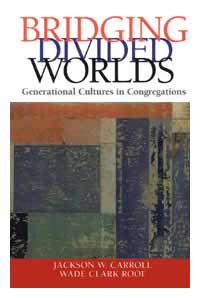 Wade Clark Roof and Jackson Carroll, in their book, “Bridging Divided Worlds”, bring us into the world of generational change with the image of ocean waves battering the shore. The image is one of both subtlety – where do you draw the line between waves – and clarity – one can see the effects of each wave.
Wade Clark Roof and Jackson Carroll, in their book, “Bridging Divided Worlds”, bring us into the world of generational change with the image of ocean waves battering the shore. The image is one of both subtlety – where do you draw the line between waves – and clarity – one can see the effects of each wave.
The authors run with the idea that major events in society during an individual’s adoslescent and early adult years shape his or her outlook. Consciousness is formed in individuals and in groups.
The first chapter goes on to list the effects of major social events on the pre-Boomers (GI Generation and Silent Generation), Boomers, and Generation Xers. The authors appear to draw heavily on the categorisation provided by Strauss and Howe.
Roof and Carroll go on to explore the impact of generational change on the social meaning of age. A classic example is the development of the ‘youth’ phase in the second half of the twentieth century. This adolescent ‘liminal phase’ was seen as a time of freedom and expressiveness rather than conformity. Add to this the more recent trends of prolonged economic dependence and birth control pills which have made it possible to postpone committed relationships and marriage.
I found the section on religion and education fascinating. The authors reflect on the increased value of higher education in emerging generations – valued largely for economic reasons. Students in the post-World War II era have been exposed to a pluralism that challenges narrow understandings of the world. Carroll and Roof believe that religion has been more and more polarised between those with a higher education and those without: people who tend to make decisions about meaning and morality with the benefit of psychology and personal experience, and people who prefer to stick to recognised sources of revelation and authority. People who value the immanent and people who value the transcendent.
I believe that organised religion in the USA is more polarised than in Australia or New Zealand. But I’m still seeing the same tension being played out in email conversations over morality and Christian faith here down under. One colleague commented on the fact that the Uniting Church in Australia tends to attract a high proportion of people who value broad education. But what’s interesting in this book is that we are seeing a higher proportion of people who have engaged in tertiary study and are reluctant to subscribe to beliefs merely on the basis of authoritative tradition or writings. I personally think it is tragic to have to choose between the immanent and the transcendent.
Jackson and Carroll go on to unpack the impact of generational change on religion and family. They say that the move away from the traditional family structures have meant that religious values are not being consistently handed down. We have moved toward a much more individualist society in which children do not necessarily adopt the values of their parents. The values of their peers are more likely to be of influence.
One comment was telling. The level of religious participation is relatively low for singles, divorced and separated, and so-called nonfamily households. It doesn’t surprise me. So many of the activities and even beliefs of the church are based around the assumption that people belong to traditional family structures. I get the impression that some churches are relieved to let people go in their early adult years – thinking they’ll fit in much more nicely when they’re married and have kids. Singles who are working out their relationships, or are in defacto relationships, who are not interested in relationships, are generally a puzzle or headache for many of our leaders. But, as the authors point out, the trend is moving further and further in this direction.
The first chapter ends with an analysis of changes brought about by the emerging generations’ ease with communication technology. It is no longer adequate to sit and listen to a sermon delivered as rhetorical logic. We’re now expecting to enter into the logic of consciousness – featuring the visual and engaging the wider experience of the participant. The authors write briefly about multigenerational congregations that attempt to hold together experience and proclaimed truth.
All this is to show that emerging generations, like waves, bring change to the whole of society. As much as some people would like to live in a generational ghetto, we’re all affected in some way by the broad sweeping movements that are emerging in our society.
